Antibody data
- Antibody Data
- Antigen structure
- References [2]
- Comments [0]
- Validations
- Immunocytochemistry [1]
- Immunohistochemistry [3]
- Other assay [4]
Submit
Validation data
Reference
Comment
Report error
- Product number
- MA5-26235 - Provider product page

- Provider
- Invitrogen Antibodies
- Product name
- TRIM38 Monoclonal Antibody (OTI15A3)
- Antibody type
- Monoclonal
- Antigen
- Recombinant protein fragment
- Reactivity
- Human, Mouse, Rat, Canine
- Host
- Mouse
- Isotype
- IgG
- Antibody clone number
- OTI15A3
- Vial size
- 100 μL
- Concentration
- 1 mg/mL
- Storage
- -20°C, Avoid Freeze/Thaw Cycles
Submitted references TRIM38 protects H9c2 cells from hypoxia/reoxygenation injury via the TRAF6/TAK1/NF-κB signalling pathway.
Tripartite motif 38 attenuates cardiac fibrosis after myocardial infarction by suppressing TAK1 activation via TAB2/3 degradation.
Lu Z, Deng M, Ma G, Chen L
PeerJ 2022;10:e13815
PeerJ 2022;10:e13815
Tripartite motif 38 attenuates cardiac fibrosis after myocardial infarction by suppressing TAK1 activation via TAB2/3 degradation.
Lu Z, Hao C, Qian H, Zhao Y, Bo X, Yao Y, Ma G, Chen L
iScience 2022 Aug 19;25(8):104780
iScience 2022 Aug 19;25(8):104780
No comments: Submit comment
Supportive validation
- Submitted by
- Invitrogen Antibodies (provider)
- Main image
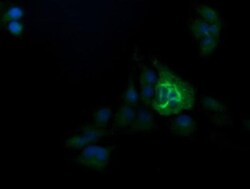
- Experimental details
- Immunofluorescent analysis of TRIM38 in COS7 cells. Cells were transfected with a plasmid overexpressing TRIM38 and probed with a TRIM38 monoclonal antibody (Product # MA5-26235).
Supportive validation
- Submitted by
- Invitrogen Antibodies (provider)
- Main image
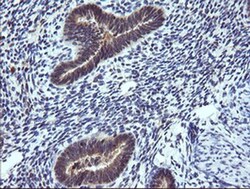
- Experimental details
- Immunohistochemistry was performed on paraffin-embedded human endometrium tissue. To expose target proteins, 10mM citric buffer, pH6.0, 120°C for 3min was used. Following antigen retrieval, tissues were probed with a TRIM38 monoclonal antibody (Product # MA5-26235).
- Submitted by
- Invitrogen Antibodies (provider)
- Main image
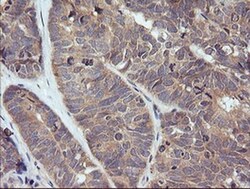
- Experimental details
- Immunohistochemistry was performed on paraffin-embedded adenocarcinoma of human ovary tissue. To expose target proteins, 10mM citric buffer, pH6.0, 120°C for 3min was used. Following antigen retrieval, tissues were probed with a TRIM38 monoclonal antibody (Product # MA5-26235).
- Submitted by
- Invitrogen Antibodies (provider)
- Main image
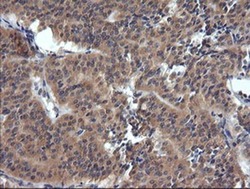
- Experimental details
- Immunohistochemistry was performed on paraffin-embedded carcinoma of human thyroid tissue. To expose target proteins, 10mM citric buffer, pH6.0, 120°C for 3min was used. Following antigen retrieval, tissues were probed with a TRIM38 monoclonal antibody (Product # MA5-26235).
Supportive validation
- Submitted by
- Invitrogen Antibodies (provider)
- Main image
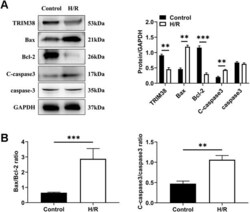
- Experimental details
- 10.7717/peerj.13815/fig-1 Figure 1 TRIM38 expression and its roles in H9c2 cells exposed to H/R. H9c2 cells were exposed to 6 h of hypoxia, followed by 6 h of reoxygenation. (A) Representative immunoblotting analysis and quantification of TRIM38, Bax, Bcl-2, C-caspase3, and caspase3 protein levels in H9c2 cells insulted by H/R or not. (B) Calculation of the ratio of Bax/Bcl2 and C-caspase3/caspase3. n = 3 for each group. ** p < 0.01 and *** p < 0.001 versus control. Unpaired two-tailed student t test for A and B.
- Submitted by
- Invitrogen Antibodies (provider)
- Main image
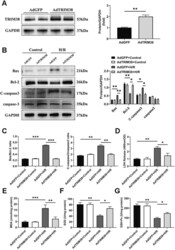
- Experimental details
- 10.7717/peerj.13815/fig-2 Figure 2 TRIM38 attenuates apoptosis and oxidative stress in H/R model. (A) Representative immunoblotting analysis (Left) and quantification (right) of TRIM38 expression in cultured H9c2 cells transfected with AdGFP or AdTRIM38. n = 4 for each group. (B) Representative immunoblotting analysis (Left) and quantification (right) of Bax, Bcl-2, C-caspase3, and caspase3 protein levels in H9c2 cells transfected with AdGFP or AdTRIM38 after H/R or not. (C) Calculation of the ratio of Bax/Bcl2 and C-caspase3/caspase3 in Control or H/R-treated H9c2 cells. (D) Effects of TRIM38 overexpression on LDH release in H/Rmodel. (E) Cellular MDA content in H/R model. (F) Cellular SOD activities in H/R model. (G) Cellular GSH-Px activities in H/R model. n = 3 for each group. * p < 0.05, ** p < 0.01 and *** p < 0.001. Unpaired two-tailed student t test for A. One-way ANOVA followed by post-hoc tests for B-G.
- Submitted by
- Invitrogen Antibodies (provider)
- Main image
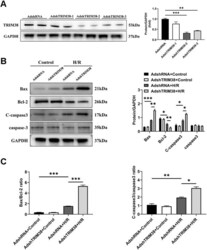
- Experimental details
- 10.7717/peerj.13815/fig-3 Figure 3 TRIM38 knockdown enhanced apoptosis in H9c2 Cells After H/R. (A) Representative immunoblotting analysis (Left) and quantification (right) of TRIM38 expression in cultured H9c2 cells transfected with AdshRNA or AdshTRIM38. (B) Representative immunoblotting analysis (Left) and quantification (right) of Bax, Bcl-2, C-caspase3, and caspase3 protein levels in H9c2 cells transfected with AdshRNA or AdshTRIM38 after H/R or not. (C) Calculation of the ratio of Bax/Bcl2 and C-caspase3/caspase3 in Control or H/R-treated H9c2 cells. n = 3 for each group. * p < 0.05, ** p < 0.01 and *** p < 0.001. One-way ANOVA followed by post-hoc tests for A-C.
- Submitted by
- Invitrogen Antibodies (provider)
- Main image
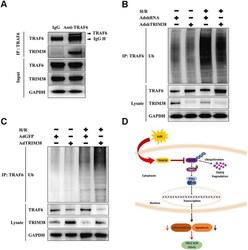
- Experimental details
- 10.7717/peerj.13815/fig-6 Figure 6 Under H/R conditions, TRIM38 degraded TRAF6 viaubiquitination. (A) H9c2 cells were subjected to H/R stimulation. Cell lysate and normal IgG antibody or TRAF6 antibody were subjected to Co-IP, and the indicated antibodies were used for immunoblotting analysis. (B-C) TRIM38 knockdown or overexpression cells were exposed with H/R. Immunoprecipitation assay was performed using lysates with anti-TRAF6 antibody. IB assay was performed using anti-TRAF6, anti-TRIM38, and anti-Ub antibodies. (D) Working model of TRIM38 protecting H9c2 cells from H/R injury by inhibiting TRAF6/TAK1/NF- kappa B signaling pathway. TRIM38 alleviated H/R-induced H9c2 injury by promoting TRAF6 degradation, which led to the inactivation of TAK1, an upstream NF- kappa B signalling molecule.
 Explore
Explore Validate
Validate Learn
Learn Western blot
Western blot Immunocytochemistry
Immunocytochemistry